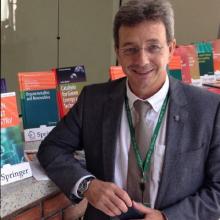Operando studies of supported oxide catalysts a complementary IR-Raman vista

Abstract
The term operando was coined to gather the growing efforts devoted to establishing structure-activity relationships by simultaneously characterizing a catalyst performance and its structure during genuine catalytic operation [1,2]. This concept started in the catalysis arena but applies to the understanding of any functional material [3]. Operando methodology results from the blend of in situ spectroscopy with the simultaneous determination of the catalytic activity (material performance) during catalytic operation. The characterization must report on phases of the material that are relevant to its performance; the performance has to be measured free of factors that distort its value. For catalytic studies case, e.g., it is critical that the operando cell results in no artefacts that would digress from its genuine value.
Supported oxide catalyst illustrates how environment affects the structure of supported oxides and operando studies correlate simultaneous determination of both, structure changes and performance changes. Complementary infrared-Raman operando studies provides insight on the states of both, catalysts structure and adsorbed species in environmental catalysis applications [5], NOx remediation [6] and toluene oxidation [4]. Computational calculations provide the rationale behind results [6].
Acknowledgements, Spanish Ministry [CTM2017-82335-R]; NSFC/RGC Joint Research Scheme [N-HKUST626/13]; and Guangzhou Collaborative Innovation Key Program [201704030074]. Also, thanks to the Oversea Research Award from School of Engineering, HKUST for supporting the exchange program at the ICP-CSIC, in Spain; FEDER-Region de Normandie “Chaire de Excellence” and h2020 project CHARISMA (research and innovation programme GA 952921).
[1] Guerrero-Pérez, M. O., & Bañares, M. A. (2002). Chem. Comm., 1292–1293.
[2] Chakrabarti, A., Ford, M. E., Gregory, D., Hu, R., Keturakis, C. J., Lwin, S., et al. (2017). Catal. Today, 283, 27–53. http://doi.org/10.1016/j.cattod.2016.12.012
[3] Bañares, M. A. (2011). Operando Spectroscopy: the Knowledge Bridge to Assessing Structure-Performance Relationships in Catalyst Nanoparticles. Adv. Mater., 23(44), 5293–5301. http://doi.org/10.1002/adma.201101803
[4] Wang, Q., Li, Y., Serrano-Lotina, A., Han, W., Portela, R., Wang, R., Bañares, M. A. and Yeung, K. L. (2021) J. Am. Chem. Soc., 143(1). http://doi: 10.1021/jacs.0c08640
[5] Ternero-Hidalgo, J. J., Guerrero-Pérez, M. O., Rodríguez-Mirasol, J., Cordero, T., Bañares, M. A., Portela, R., Bazin, P., Clet, G. & Daturi, M. Anal Chem (2020). doi:10.1021/acs.analchem.9b05473
[6] Rasmussen, S. B., Portela, R., Bazin, P., Ávila, P., Bañares, M. A. & Daturi, M. Appl Catal B Environ 224, 109–115 (2018).
[7] Lewandowska, A. E., Calatayud, M., Tielens, F. & Bañares, M. A.. J Phys Chem C 115, 24133–24142 (2011).